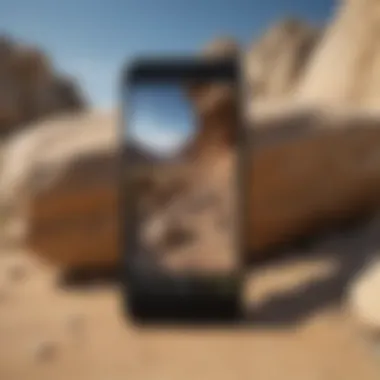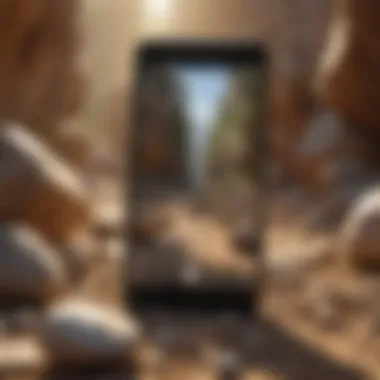Unlock the Mysteries of Rocks with the Ultimate Rock Identifier App: A Comprehensive Guide


Rock and Fossil Identification
Exploring the realm of rock and fossil identification is a fascinating journey that requires a keen eye and an understanding of various types of rocks and fossils. From igneous and sedimentary rocks to ammonites and trilobites, the world of geology is vast and diverse. Collectors should pay attention to key characteristics such as color, texture, and grain size to discern one specimen from another. Utilizing tools like magnifying glasses, streak plates, and even specialized rock hammers can aid in the identification process.
Collecting Tips and Techniques
Effective rock and fossil collecting involves more than just scouring the surface - it is a blend of art and science that requires precision and caution. To maximize success, collectors should adhere to best practices such as obtaining permits for collecting in specific areas, respecting nature while extracting specimens, and documenting the location and date of each find. Locating prime collecting sites involves research and exploration, be it combing through geological maps or seeking guidance from local experts. Safely extracting specimens requires tools like chisels, goggles, as well as a delicate touch to avoid damaging the specimen.
Preservation and Display
Preserving rocks and fossils ensures their longevity and allows collectors to showcase their treasures. Techniques such as cleaning with soft brushes, stabilizing fragile specimens with consolidants, and storing in acid-free containers can prevent degradation. Proper storage methods involve keeping specimens away from sunlight, moisture, and extreme temperatures to maintain their integrity. Creative display ideas range from traditional shadow boxes to custom-built shelving, enhancing the aesthetic appeal of any collection.
Geological Insights
Delving into the geological insights offered by rocks and fossils uncovers the Earth's history, processes, and significance. From understanding how geological formations like faults and folds are created to unraveling the historical significance of rocks that hold clues to past climates and ecosystems, each discovery opens a window to the planet's past. Notable finds in the field, whether it be a rare dinosaur fossil or a unique mineral specimen, contribute to scientific knowledge and enrich the collective understanding of our world.
Introduction
In the realm of rock and fossil collecting, the utilization of a cutting-edge rock identifier app stands as a pivotal advancement for enthusiasts keen on identifying and categorizing geological treasures. This comprehensive guide aims to unveil the intricate functionalities of the app, unveiling a world where technology seamlessly intertwines with the passion for earth's ancient wonders.
Grounded in a meticulous approach, this article delves deep into the significance of proper rock identification, echoing the essence of preserving geological heritage and steering clear of misattributions that can dilute the authenticity of collections. As collectors strive to enhance the value of their assemblages, the reliance on advanced tools such as the Rock Identifier App becomes not just a convenience but a necessity in the pursuit of a meticulously curated collection.
Moreover, as we embark on this journey through the digital realm of rock identification, a key emphasis is placed on the benefits conferred by such innovative applications. Efficiency in specimen identification, amplification of educational resources, and the facilitation of organizational tools underscore the pivotal role played by the app in revolutionizing the collecting experience for aficionados. Through a blended fusion of technology and tradition, this guide endeavors to transcend mere gadgetry and delve into the very heart of what it means to pay homage to the geological marvels that Earth has bestowed upon us.
Understanding Rock Identification
In this article, the topic of Understanding Rock Identification is paramount for rock and fossil collectors seeking to deepen their knowledge and enhance their collection curation process. Understanding Rock Identification involves delving into the key features that make each rock unique, from mineral composition to physical characteristics. By accurately identifying rocks and fossils, collectors can gain a deeper appreciation for the geological world and better comprehend the historical context of their specimens.
Key Features of the Rock Identifier App
Image Recognition Technology
Image Recognition Technology is a pivotal aspect of the Rock Identifier App, revolutionizing the way collectors identify specimens. By utilizing advanced algorithms, this feature allows users to snap a photo of a rock or fossil and receive instant results. The convenience and accuracy of Image Recognition Technology streamline the identification process, making it an indispensable tool for collectors who want efficiency without sacrificing accuracy.
Comprehensive Database
The Comprehensive Database integrated into the Rock Identifier App is a treasure trove of information for enthusiasts. The database houses a vast collection of rock and fossil data, including images, descriptions, and geological details. With access to such a comprehensive resource, users can swiftly cross-reference their specimens and expand their knowledge base with ease.
User-Friendly Interface


The User-Friendly Interface of the app ensures a seamless user experience for both novices and seasoned collectors. Its intuitive design simplifies navigation and ensures that even beginners can leverage the app's full potential without any learning curve. The clean layout and practical features make the app a favorite among users seeking a hassle-free identification tool.
Benefits of Using a Rock Identifier App
Efficient Specimen Identification
Efficient Specimen Identification through the app accelerates the cataloging process, saving collectors valuable time and effort. With quick and accurate results at their fingertips, users can swiftly categorize their finds and focus on expanding their collection without the bottleneck of manual identification.
Educational Resource
Diving into the Educational Resource section of the app offers users a wealth of knowledge about various rocks and fossils. Detailed descriptions, geological insights, and historical significance provided for each specimen contribute to a holistic learning experience, enriching collectors' understanding of the earth's geological diversity.
Organizational Tool
The Organizational Tool feature acts as a virtual curator, helping collectors manage and organize their collections effectively. With customizable organization options, users can arrange their specimens based on geological properties, locations, or personal preferences, enhancing both the visual appeal and practicality of their collections.
Importance of Proper Rock Identification
Proper Rock Identification is essential for preserving the integrity of geological heritage and preventing misattributions that can devalue or misrepresent specimens. By accurately identifying rocks, collectors contribute to the conservation of natural history and ensure the scientific accuracy of their collections. Moreover, proper identification enhances the overall value and credibility of a collector's inventory, establishing them as knowledgeable and trustworthy enthusiasts in the community.
Preservation of Geological Heritage
Preservation of Geological Heritage plays a crucial role in safeguarding important geological specimens for future generations. By identifying rocks accurately and documenting their provenance, collectors contribute to the preservation of invaluable geological records, ensuring that these treasures remain available for scientific study and public appreciation.
Avoiding Misattributions
Avoiding Misattributions is a key consideration in rock identification to prevent mislabeling or misinterpretation of specimens. Through meticulous identification efforts and reliance on accurate resources like the Rock Identifier App, collectors can avoid errors that might lead to incorrect classification or historical inaccuracies, maintaining the integrity of their collections and the broader geological record.
Enhancing Collection Value
Enhancing Collection Value through proper rock identification adds prestige and authenticity to a collector's portfolio. By accurately identifying rare or unique specimens, collectors can increase the value and desirability of their collections, attracting opportunities for collaboration, exhibition, or investment. Additionally, transparent and well-documented identification practices elevate the overall credibility and marketability of a collector's assets.
Exploring the Functionality
In this section, we delve into the crucial aspects of the functionality of the Rock Identifier App, a fundamental component of this comprehensive guide for rock and fossil collectors. Understanding the functionality of the app is paramount as it forms the backbone of the user experience, shaping how enthusiasts interact with the tool. By exploring the functionality, users can grasp the full scope of capabilities that the app offers, ranging from specimen identification to data management. This detailed analysis serves to equip collectors with a deep understanding of how to leverage the app to enhance their collecting journey.
Step-by-Step Guide to Using the Rock Identifier App
Downloading the App:
When it comes to utilizing the Rock Identifier App, the initial step involves downloading the application onto the user's device. This process is essential as it grants access to the app's extensive features and functionalities, setting the groundwork for efficient specimen identification and cataloging. The convenience of downloading the app lies in its seamless integration with various devices, ensuring accessibility for a wide range of users. Additionally, the user-friendly interface makes the download process a smooth and hassle-free experience.


Uploading Images:
Uploading images to the Rock Identifier App plays a pivotal role in the identification process. By capturing and uploading images of geological specimens, users can harness the power of image recognition technology embedded within the app. This feature allows for accurate and efficient identification of rocks and fossils based on visual cues, enhancing the overall user experience. The ability to upload images directly facilitates quick and precise analysis, enabling collectors to identify their finds with ease.
Analyzing Results:
Once images are uploaded, the app proceeds to analyze the visual data to provide users with insightful results. The analysis phase is essential for generating detailed information about the identified specimen, including its geological classification and relevant characteristics. By meticulously scrutinizing the results, collectors gain valuable insights into the composition and origins of the rock or fossil, enriching their knowledge base. The app's robust analytical capabilities ensure accurate and reliable results, contributing to a seamless identification process.
Utilizing Advanced Features
Within the Rock Identifier App, a suite of advanced features caters to the diverse needs of rock and fossil collectors, elevating their collecting experience to new heights. These advanced features extend beyond basic identification functions, offering additional tools and resources to enrich the user experience.
Geological Data Insights:
Among the advanced features, Geological Data Insights stand out as a valuable resource for enthusiasts seeking in-depth information about geological specimens. This feature provides access to detailed geological data, such as mineral composition, formation processes, and geographic origins. By incorporating geological data insights into their analysis, collectors can gain a deeper understanding of the rocks and fossils in their collection, fostering an educational and enriching experience.
Collection Management Tools:
Another critical aspect of the app's functionality is the provision of Collection Management Tools, designed to streamline the organization and cataloging of geological specimens. These tools offer collectors a systematic way to manage their collections, including features for categorization, labeling, and inventory tracking. By utilizing collection management tools, enthusiasts can maintain a structured and efficient database of their finds, enhancing both preservation and accessibility.
Community Interaction:
The aspect of community interaction within the Rock Identifier App fosters a sense of belonging and collaboration among collectors. Through community features such as virtual trading platforms, discovery challenges, and expert consultations, users can engage with fellow enthusiasts, exchange knowledge, and seek guidance from experts in the field. This interactive component not only enhances the social aspect of collecting but also facilitates learning and discovery through shared experiences and perspectives.
Enhancing the Collecting Experience
Integrating Field Notes and Observation
Recording Geological Context Field notes play a pivotal role in enhancing the collecting experience by providing valuable insights into the geological context of specimens. By diligently recording the geological context in which rocks and fossils are found, collectors can better understand the environment in which these specimens originated. This detailed information allows for a more comprehensive interpretation of the specimen's history and geological significance. Recording geological context is essential for accurately cataloging specimens and preserving their scientific value. Collectors can note factors such as stratigraphy, sedimentary structures, and geographic location, which aid in the proper classification and identification of rocks and fossils. This meticulous approach adds depth to the collector's understanding and appreciation of their collection. While the process may require attention to detail, the benefits in terms of scientific accuracy and educational value make it a worthwhile endeavor.
Noting Physical Characteristics
Noting physical characteristics is a fundamental aspect of fieldwork that significantly contributes to the collecting experience. By meticulously documenting the physical attributes of specimens, collectors can create a detailed record of their collection, enabling accurate identification and classification. Physical characteristics such as color, texture, crystal structure, and mineral composition offer crucial information about the geological origin and formation of rocks and fossils. This attention to detail not only aids in proper identification but also enhances the aesthetic appeal of the collection. Collectors who take the time to note physical characteristics create a valuable resource for future reference and scientific study. While it requires patience and keen observation, the practice of noting physical characteristics enriches the collecting experience and fosters a deeper connection to the specimens being collected.
Tracking Locations
Tracking locations where specimens are collected plays a vital role in documenting the provenance of rocks and fossils. By recording the geographical coordinates or detailed descriptions of collection sites, collectors establish a chronological record of their exploration and discoveries. Tracking locations not only aids in cataloging specimens but also enables collectors to revisit sites for further study or additional collection. Understanding the geographic context of specimens provides valuable insights into the regional geological history and biodiversity. Furthermore, tracking locations can help prevent illegal collection practices and promote ethical collecting behavior. While maintaining detailed location records requires diligence and organization, the benefits in terms of scientific research, conservation, and responsible collecting practices are immeasurable.
Collaborative Features for Collectors


Virtual Trading Platform
A virtual trading platform serves as a dynamic hub for collectors to exchange specimens, knowledge, and experiences within a supportive community. This feature allows enthusiasts to showcase their collections, engage in trades, and expand their network of fellow collectors. The virtual trading platform facilitates the exploration of a diverse range of specimens from around the world, enabling collectors to acquire new additions to their collection or trade duplicates for rarer finds. The interactive nature of the platform fosters a sense of camaraderie and collaboration among collectors, promoting a culture of sharing and learning. This virtual marketplace creates opportunities for enthusiasts to connect, interact, and build relationships based on a shared passion for rocks and fossils. While participation in virtual trading requires caution and ethical consideration, the platform offers a unique avenue for collectors to enrich their collecting experience and broaden their understanding of geological diversity.#### Discovery Challenges Engaging in discovery challenges adds an element of excitement and adventure to the collecting experience, encouraging collectors to explore new sites and expand their knowledge base. These challenges present collectors with specific tasks or objectives related to specimen identification, fieldwork techniques, or geological exploration. By participating in discovery challenges, collectors can test their skills, learn from peers, and discover hidden gems within their collection areas. The competitive aspect of challenges motivates collectors to push their boundaries, uncover rare specimens, and contribute to the scientific community. Discovery challenges not only stimulate curiosity and exploration but also promote a spirit of discovery and camaraderie among collectors. While embarking on challenges requires careful planning and safety considerations, the rewards in terms of personal growth, knowledge acquisition, and community engagement are invaluable.#### Expert Consultation Seeking expert consultation can provide invaluable guidance and expertise to collectors navigating complex identification or geological issues. Experts in the field offer insights, advice, and specialized knowledge to assist collectors in understanding the scientific aspects of their collection. Whether identifying challenging specimens, interpreting geological formations, or discussing conservation practices, expert consultation enhances the educational value of the collecting experience. Access to expert input allows collectors to expand their knowledge, refine their skills, and address uncertainties or ambiguities in their collection. The wisdom and experience shared by experts contribute to the growth and development of collectors, fostering a deeper appreciation for the geological world. While seeking expert consultation requires humility and openness to feedback, the opportunity to learn from established professionals enriches the collecting experience and furthers the pursuit of knowledge and discovery.
Community Engagement
Community engagement plays a pivotal role in the realm of rock and fossil collecting, fostering connections and knowledge sharing among enthusiasts. By being actively involved in a community, collectors can gain insights, support, and a sense of belonging that enriches their collecting experience.
Connecting with Fellow Enthusiasts
Discussion Forums
Discussion forums serve as virtual meeting places where collectors can discuss various topics, share experiences, seek advice, and showcase their finds. These forums create a platform for enthusiasts to engage with like-minded individuals from diverse backgrounds, fostering a sense of community and camaraderie. The interactive nature of discussion forums allows for real-time conversations, enabling members to learn from each other's expertise, discoveries, and perspectives. This open exchange of knowledge and ideas enhances the overall collective understanding of rocks and fossils, making it a vital component of this article's focus on community engagement.
Events and Meetups
Events and meetups provide opportunities for collectors to interact in person, attend lectures, participate in field trips, and network with experts in the field. These gatherings offer a chance to deepen connections, share field experiences, and learn firsthand from seasoned collectors and geologists. The physical interaction at events and meetups fosters a sense of camaraderie and shared enthusiasm, promoting a collaborative spirit among collectors. This direct engagement enhances the community's cohesion and enriches the overall collecting experience highlighted in this article.
Knowledge Sharing
Knowledge sharing platforms enable enthusiasts to disseminate information, insights, and research findings within the community. Through shared articles, educational resources, tutorials, and workshops, collectors can enhance their understanding of geological specimens, identification techniques, and preservation methods. Knowledge sharing not only empowers individual collectors but also contributes to the collective expertise of the community. By facilitating the exchange of information and expertise, knowledge sharing platforms uphold the spirit of collaboration and continuous learning that is integral to the community engagement discussed in this article.
Contributing to the Rock Identifier App
Submitting New Specimens
Submitting new specimens to the rock identifier app enables collectors to expand the database, contribute to scientific knowledge, and showcase their discoveries to a wider audience. By sharing images and detailed descriptions of their finds, collectors enrich the app's catalog with diverse specimens, helping others in their identification quests. This collaborative effort enhances the accuracy and comprehensiveness of the app's database, making it a valuable resource for collectors and researchers alike.
Improving Database Accuracy
Improving database accuracy involves verifying, updating, and refining the information within the rock identifier app to ensure that it remains up-to-date and reliable. Collectors can help correct errors, add new data, and enhance the app's functionality by providing feedback and suggestions for improvement. By actively participating in database accuracy initiatives, collectors contribute to maintaining the app's credibility and utility, facilitating more accurate specimen identifications and enhancing the overall user experience.
Providing Feedback
Providing feedback on the rock identifier app allows collectors to communicate their experiences, suggestions, and concerns to the app developers, fostering a user-centric approach to app development. By sharing their feedback on usability, features, accuracy, and overall performance, collectors influence the app's future enhancements and updates. This direct line of communication between users and developers promotes a responsive and adaptive app environment that caters to the evolving needs and preferences of the collecting community. Feedback mechanisms ensure continuous improvement and innovation within the app, aligning it more closely with the users' expectations and requirements in this dynamic and engaging ecosystem.
Conclusion
In this comprehensive guide on the Rock Identifier App designed for rock and fossil collectors, we have explored the various aspects and functionalities that make this app indispensable for enthusiasts. The importance of a conclusive section lies in its ability to summarize key takeaways and emphasize the significance of proper rock identification in the realm of geological specimen collection.
One of the essential elements encapsulated in the conclusion is the efficiency of the Rock Identifier App in streamlining the identification process. By utilizing image recognition technology and a vast database, users can accurately identify rocks and fossils, thus enhancing their collecting experience. Moreover, the user-friendly interface ensures that even beginners can navigate the app effortlessly.
Furthermore, the benefits of using the app extend beyond mere identification. It serves as an educational resource, providing valuable insights into the world of geology and helping users learn more about their discoveries. Additionally, the organizational tools integrated into the app assist collectors in cataloging their specimens effectively.
Another critical point to consider in this conclusion is the impact of proper rock identification on the preservation of geological heritage. By accurately identifying rocks and fossils, collectors contribute to the conservation of these significant specimens for future generations. Avoiding misattributions also helps maintain the integrity of geological records and research.
Ultimately, the Rock Identifier App not only enhances the value of a collector’s assortment but also fosters a deeper appreciation for the geological world. By embracing technology to aid in rock and fossil identification, enthusiasts can expand their knowledge, connect with a community of like-minded individuals, and actively contribute to the advancement of the field. The conclusion underscores the importance of leveraging innovative tools in rock and fossil collecting, emphasizing the enduring relevance of proper identification practices in preserving our geological heritage.







